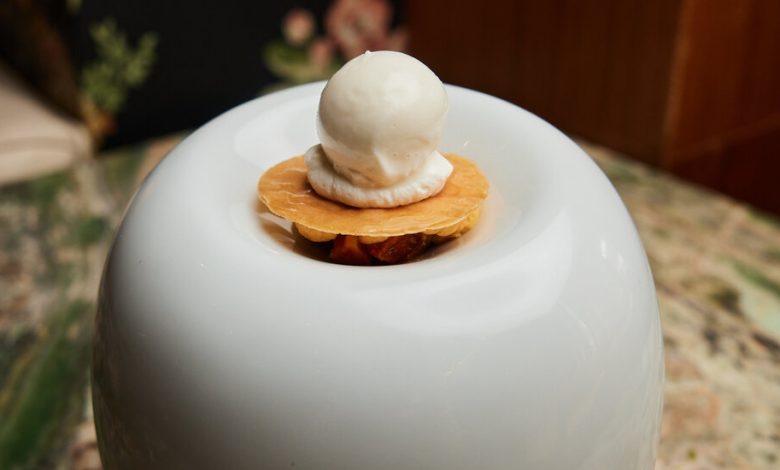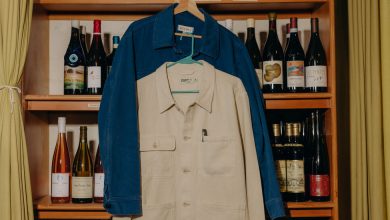Why Is My Dessert on a Pedestal? 7 New Styles at the Restaurant Table.

At the restaurant ILIS in Brooklyn, your smoked tomato and clam dashi arrives in a giant clamshell, sealed with beeswax and roped shut. At Naks in the East Village, bites of beef tartare on crisped beef fat are ferried to your table on a cow horn.
The post-plate era of fine dining is in full swing. Chefs at influential restaurants around the world are sending out food on surfaces like a pink silicone tongue, a bird’s nest, a gilded picture frame and an egg-shaped porcelain pedestal.
They’re the most extreme of several new twists in plating — the art of arranging food for maximum visual appeal that can define a chef’s work and help her win Michelin stars.
French tradition long dictated the “clock rule”: Place protein and sauce at 6, vegetables at 2, starch at 10, all on spotless white porcelain. When the Japanese-influenced nouvelle cuisine movement took off in the 1980s, chefs began removing heavy sauces and tidying up the food underneath.
Soon, stacking up the components of a dish on square or rectangular plates and decorating them with colorful dots, squiggles and swooshes became the signature look of the 1990s. (Cue the opening credits of the 2000 film “American Psycho,” a sequence of blood-red droplets against a white background that turn out to be spatters of raspberry coulis on a plate at Dorsia, the movie’s hypertrendy restaurant.)
The 2000s brought glossy, mechanical molecular gastronomy from El Bulli in Spain, followed by Noma’s New Nordic minimalism, with its carefully tweezed tufts of herbs and the textures and shades of the Scandinavian landscape.
And then Instagram blew it all wide open. Today’s chefs can adopt a different style for each course: free-form, organic, futuristic or no plate at all. As always, some artists express the aesthetic of their time with grace; others jump the shark with impractical (if intriguing) presentations. A lively Reddit forum called WeWantPlates mocks clout-chasing restaurant dishes like tacos hung from tiny clotheslines, hummus scooped into trowels and citrus foam oozing from a white plaster cast of the chef’s mouth.
Here are some of the prevailing strategies in plating, all spotted recently in New York City, a leader in fine-dining trends (and not coincidentally, in expense-account spending):
Shingle All the Way

Credit…Evan Sung
Instagram’s outsize influence on modern chefs shows up most often in this eye-catching form: pale, pristine ingredients fanned out like flower petals or overlapping shingles. Estela, which opened in 2013, rode to fame on plates topped with overlapping mushroom slices and endive leaves. Eleven Madison Park does it in all seasons (above, with summer radishes). Le Bernardin transforms an artichoke (below) into a silky pleated skirt.
Top It With a Tuile
Tuiles — crisp cookies with a natural lace of caramelized sugar — are regular dessert toppers. But chefs have begun deploying fruits and vegetables, dehydrators and silicone molds to make intricate geometric patterns in flavors as diverse as milk, saffron and “everything” seasoning. Atomix has mastered this presentation with leaflike shapes (above, a burdock-flavored tuile crowns a turbot dish with parsnips and grapes). A new version of the classic molten chocolate dessert (below) at the just-reopened Café Boulud sports a jaunty pale-green tuile topper.
Play It Close to the Edge
Restaurant food has been migrating from the center for quite some time; a cliché of modern plating is a dish with meat or fish on one edge, vegetables on the other and swooshes and sprigs filling the space in between. Recently, chefs have been pushing the whole dish to one side of the plate. At Noksu, pieces of vinegar-cured sardine garnished with tiny blooms (above) rest on the outer limit of the plate. Francie’s signature market salad (below) reaches for the edge. The “soil” made of black olives that’s scattered on the plate is a holdover from the molecular gastronomy era, when making hypertechnical food look “natural” was all the rage.
Go Big, and Small
Designing dishes with “negative space” has long been a way for American chefs to incorporate the Japanese influence on plating that began with nouvelle cuisine and continues today. According to the aesthetic of ma, or emptiness, open space sets off the beauty of the focal point. Chefs are now exaggerating the effect by choosing bigger and bigger plates, so the negative space nearly swallows the object. Nosku’s luminously shingled brown crab tart (above) rests at the center of concentric rings of porcelain. Trendy puffy plates, as used at Gabriel Kreuther to present a tiny sweet-potato dessert (below), create pillowy fields of white.
Flood the Zone
At the opposite end from fine dining’s standard small bites are plates that are filled up or even flooded. This style spreads plentiful, welcoming vibes — though it doesn’t always provide the most practical way to eat a saucy dish. Tatiana by Kwame Onwuachi serves its curried crab (above) spread out on a flat plate, circled by a moat of sauce and dotted with chile oil. And a wash of jus pulls together the brilliantly simple plate of sausage and mashed potato (below) at Libertine.
Show Some Leg
The fashion of serving great big birds that began in 2012 at the NoMad (since closed) has found many expressions (more recently at Sailor and Torrisi). Fine-dining restaurants usually turn to neat, boneless cuts like breasts, medallions and cutlets, but chefs have begun sending out chickens and ducks with the feet still attached. Crown Shy’s signature dish (above) might read as just another spicy chicken without the conspicuous claw that curves over, and sometimes off, the plate. (Note that this plate also illustrates two of our other trends: nudging the food to one side, and shingling it with leaves). And like many dishes at ILIS, including the clam broth inside a clamshell, the whole roast duck there is served in a close-to-natural state, with the feet still attached.
Ditch the Plate
For chefs who hope to express creativity and courage, the latest temptation is to eliminate plates altogether. But practically speaking, something has to carry the food from the kitchen to the table. In recent workarounds, Torrisi lays its pink ribbons of prosciutto (above) on custom-made butcher paper. Naks is serving nearly every course in its Filipino-inspired tasting menu (below, atop a cow’s horn) on organic materials like banana leaves and pieces of the wood that lines the restaurant’s walls. And with the elimination of the plate, the evolution of plating may have come full circle.
Follow New York Times Cooking on Instagram, Facebook, YouTube, TikTok and Pinterest. Get regular updates from New York Times Cooking, with recipe suggestions, cooking tips and shopping advice.



